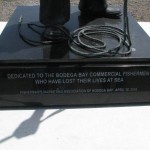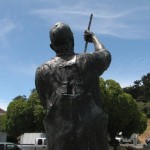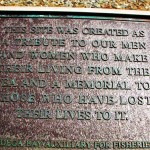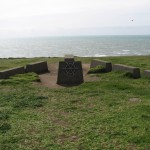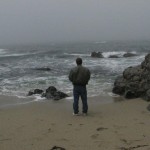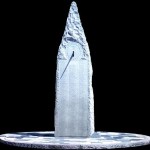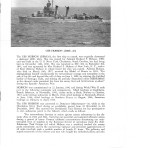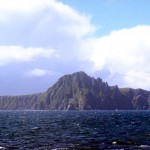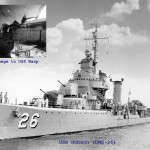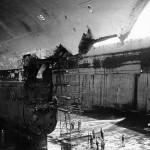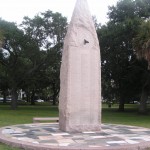Archive for June, 2010
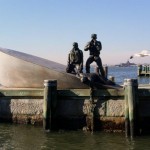 One of the most memorable lost at sea memorials anywhere is located on the west side of Battery Park in Manhattan, near the line to board the ferries to the Statute of Liberty and Ellis Island. The memorial was designed and fabricated by the artist Marisol Escobar, based on a photograph from an actual event during WWII. In that event a German submarine attacked and sank an American merchant vessel, thought to be an oiler. The submarine surfaced and took photographs of the survivors. The memorial depicts the scene in one of those photographs. The submarine did not pick up the survivors. They were all lost at sea in the vast Atlantic.
One of the most memorable lost at sea memorials anywhere is located on the west side of Battery Park in Manhattan, near the line to board the ferries to the Statute of Liberty and Ellis Island. The memorial was designed and fabricated by the artist Marisol Escobar, based on a photograph from an actual event during WWII. In that event a German submarine attacked and sank an American merchant vessel, thought to be an oiler. The submarine surfaced and took photographs of the survivors. The memorial depicts the scene in one of those photographs. The submarine did not pick up the survivors. They were all lost at sea in the vast Atlantic.
The brilliance of Marisol’s design can best be appreciated by viewing the monument over an extended period of time. At periods of high tide one can only see a hand sticking out of the water. When the tide is lower one can see the hand and the stricken seaman’s head, and at other times his entire upper torso. As ships pass by, the waves created give the memorial a sense of life and motion. The seaman’s head bobs above and below the water’s surface, as the arm of a seaman in a lifeboat strains to save his shipmate. Two others on the lifeboat are looking directly at the submarine, which will eventually submerge again and leave them for dead. There is a plaque at the memorial that reads:
Dedicated to all Merchant Mariners who have served America from the Revolutionary War through the present day. In the prosecution of war and in pursuit of peaceful commerce, unrecognized thousands have lost their lives at sea. Their sacrifices have helped secure America’s liberty and prosperity.The sculpture was inspired by a photography of the victims of a submarine attack on an American merchant ship during World War II. Left to the perils of the sea, the survivors later perished.
This memorial serves as a marker for America’s Merchant Mariners resting in the unmarked ocean depths.
A new and well-conceived memorial to those lost at sea was recently dedicated close to my home in Northern California. The Commercial Fisherman Memorial is located at Spud Harbor in Bodega Bay, California. The statue pays tribute to the commercial fisherman lost at sea after sailing from Bodega Bay. These include those fishing for salmon, crab, abalone, and rockfish over the past two centuries. Names of lost fishermen will be added to the memorial beginning in April 2011 – and I suspect for many years to come.
The fishing industry is in dire straits around the world. The reasons are well known – overfishing, man-made and natural disasters, global climate change, and pollution. Fishermen work harder, longer, and take more risks for a continuing reduced reward. One can only hope that their fortunes change in the coming decades. Memorials such as the Bodega Bay Memorial and others around the world serve to remind us all of the sacrifices made for centuries by commercial fishermen.
If you’re near Bodega Bay, I encourage you to take the hike around Bodega Head. Placed on a cliff looking west towards the Pacific is another small memorial to the fishermen of Bodega Bay. Gazing at the Pacific from the memorial site is always a reminder of the risks taken every day by commercial fishermen. Walk down to the water’s edge from the memorial on a less than perfect day and the reality of what commercial fisherman face daily can begin to be appreciated.
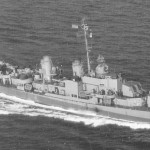
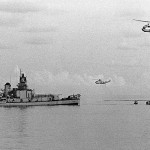 On the night of June 3, 1969 the U.S.S. Frank E. Evans (DD-754) was involved in a collision with the Royal Australian Navy aircraft carrier Melbourne in the South China Sea – an accident eerily similar to the U.S.S Hobson/U.S.S Wasp collision 17 years before. Flight operations were in progress on the Melbourne and the Evans was maneuvering into its correct position reference to the carrier. As in the Hobson incident, an error in judgement was made on the bridge of the Evans. The Melbourne struck Evans amidships, cutting her in half. The bow section of the Evans sank almost immediately, taking 74 of her crew to their deaths. One body was recovered, 73 were lost at sea. The photos at the top left show the Evans before and after the accident.
On the night of June 3, 1969 the U.S.S. Frank E. Evans (DD-754) was involved in a collision with the Royal Australian Navy aircraft carrier Melbourne in the South China Sea – an accident eerily similar to the U.S.S Hobson/U.S.S Wasp collision 17 years before. Flight operations were in progress on the Melbourne and the Evans was maneuvering into its correct position reference to the carrier. As in the Hobson incident, an error in judgement was made on the bridge of the Evans. The Melbourne struck Evans amidships, cutting her in half. The bow section of the Evans sank almost immediately, taking 74 of her crew to their deaths. One body was recovered, 73 were lost at sea. The photos at the top left show the Evans before and after the accident.
The whole story of the Evans can be found at the superb website of the U.S.S. Frank E. Evans (DD-754) Association: http://ussfrankeevansassociationdd754.org
Spend some serious time on this website. It is the finest website devoted to a single ship that I have ever seen, lovingly maintained by former members of the Evans crew during her long and proud history. She served in three wars with distinction. Her entire history is contained within the website. There are several memorials to the Evans’ lost souls in the United States, including one in Arlington National Cemetery. There is also a beautiful memorial in Australia.
There is one memorial to the Evans in the United States that personalizes the tragedy beyond all the others, however. It is not large in size. I doubt if it was designed by a professional artist or cost as much as the other Evans memorials. It is not on the beaten track either – it’s located on a plaza in a very small town called Niobrara, Nebraska.
Among the dead and forever lost at sea on that awful night in 1969 were three brother from Niobrara – Gary, Kelly and Gregory Sage. It was the worst single family toll in the U.S. Navy since the five Sullivan brothers were killed in the sinking of the U.S.S Juneau in 1942 near Guadalcanal. Even today, after four decades have passed, it’s difficult to comprehend the sense of loss that must have been felt by the brothers’ parents, the widow of one of the brothers, the immediate family, and the entire small Nebraska town that they called home.
The memorial is in two parts. One is a plaque that describes the accident. In front of and below the plaque, resting on the ground, is a simple granite block. On the front of that block are five words, one date, and a single oval photograph. The power of that photograph is how it humanizes the loss of all those souls that night. It’s hard to imagine a more powerful image on any memorial anywhere.
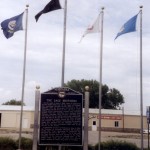
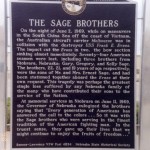
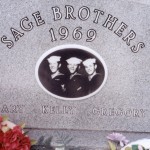 For more information on the Sage brothers and the 1999 dedication of this memorial, please visit the U.S.S. Frank E. Evans Association website and click their ‘News’ section. Under the same section you will find photographs of all the sailors who died that night and forever rest in the deep waters of the tropical Pacific.
For more information on the Sage brothers and the 1999 dedication of this memorial, please visit the U.S.S. Frank E. Evans Association website and click their ‘News’ section. Under the same section you will find photographs of all the sailors who died that night and forever rest in the deep waters of the tropical Pacific.
U.S.S Hobson Memorial Image © Brown Memorials
Through the kindness of Claudia Brown, President of Brown Memorials of Florence, South Carolina, I have obtained some fascinating additional information on the U.S.S Hobson Memorial in Charleston. Claudia provided me with a copy of the original program given out at the 1954 dedication of the monument. I have turned this document into scanned files to share with everyone. My apologies for the light quality of the scans. It’s a 56 year old document and is somewhat faded.
The program contains significant information on the history of the Hobson, the thought process on the design of the memorial, a dedication and listing of the 176 crew members lost in the accident, a listing of the surviving crew, and a discussion of the Memorial Society, whose hard work and dedication resulted in this permanent memorial. Claudia also provided some additional information, which I quote below:
“As a member of the American Institute of Commemorative Art, my father Bill Brown, of Brown Memorials, and Harold Schaller of Peacock Memorials in Valhalla, NY worked together on the project. It may interest you to know that this monolith made from Salisbury Pink granite quarried in Salisbury, NC, was at that time the largest piece of stone quarried from that site. It was so large that the names and carving had to be sandblasted into the stone before it was removed from the quarry.”
My sincere appreciation to Claudia Brown for providing the Dedication Program attached below. I’ll be highlighting other Brown designed memorials in future posts. Their web site can be visited at http://www.brownmemorials.com/index.html. Be sure to check out their Gallery Section, especially ‘Civic’ for other memorable Brown memorials.
And now the U.S.S. Hobson Memorial Dedication Program from 1954:
Cape Horn…
For almost 600 years mariners have considered this single geographic spot to be the end of the world. Talk to anyone who has ever sailed on the oceans and the words ‘Cape Horn’ contain equal measures of dread, mystery, and anticipation. Cape Horn is the ultimate challenge – Cape Horn is their deepest fear.
Books abound about the challenges of sailing around Cape Horn. Two of the very best are Two Years Before the Mast by Richard Henry Dana, Jr. and The Last Time Around Cape Horn (The Historic 1949 Voyage of the Windjammer Pamir) by William F. Stark. Much more will be written about the ill-fated Pamir in later posts. The history of the Pamir is fascinating – fifty years under sail in war and peace under national several flags. Stark’s fine book tells the story of Pamir’s final journey around Cape Horn – which turned out to be the very last navigation around Cape Horn by any commercial sailing vessel.
A voyage around Cape Horn under sail is generally defined as a voyage of at least 3,000 nautical miles which must pass through 50 degrees South Latitude in both the Atlantic and Pacific (or Indian) Oceans. This would place the vessel only 600 nautical miles north of Antarctica. ‘Under Sail’ means that the use of any propulsion except the wind is prohibited. It is a challenge and it is dangerous, but once it was somewhat common. Today it is an extremely rare event – best said in a quotation from the web site of the International Association of Cape Horners:
“Cape Horn is sometimes called the Mount Everest of sailing. Mount Everest was first climbed on 29th May, 1953. We believe that, since that date, fewer people have qualified for full membership of the IACH than have climbed Mount Everest.”
A superb site to discover the IACH and the history of sailing Cape Horn can be found at http://www.capehorners.org/. Take the time to visit and browse their ‘Related Items’ page. It will take you to the web sites of their international chapters, links to videos of sailing Cape Horn, satellite photographs of the area – even information on visiting the area. Perhaps no other spot on earth contains as many souls lost at sea
First and foremost, the beautiful photograph and poem seen on my previous post was directly taken from a web site of the Chilean chapter of The Amicale Internationale des Capitaines au Long Cours Cap Horners – The International Association of Cape Horners. This association has chapters in several countries. Full membership in the I.A.C.H. is available only “for those who have voyaged around Cape Horn under sail”. This must be an exclusive club indeed.
Please visit http://www.caphorniers.cl/CH_monument.htm to read the fascinating details about the design and construction of this beautiful memorial at the end of the world.
My next post will discuss more about the I.A.C.H., links to their web sites worldwide, and much more about the legendary Cape Horn.
Designed by Lissette Moreno
Copyright © 1999 – 2010 Brotherhood of Cape Horners – Chilean Section.
All rights reserved.
 |
|
As a veteran of Naval Aviation, I have witnessed first-hand the dangers of aircraft carrier operations. While flight operations are being conducted, the activities above and below decks on a carrier must be meticulously coordinated. Mistakes all too often lead to serious accidents.
This careful coordination of activities extends beyond the aircraft carrier itself, to the support ships that escort the carrier. When viewed from an aircraft above, these support ships constantly engage in a precise ballet to remain in the proper position closely aft and to the side of the carrier to support flight launch and recovery operations. This is not an easy task. The carrier is always ‘chasing the wind’ – constantly changing heading and speed to keep sufficient wind flowing directly down the deck. The support ships are tasked with keeping proper position in relation to the carrier, often at night or in bad weather and heavy seas.
The U.S.S. Hobson (DD-464) , a Gleaves-class destroyer was built at the Charleston Navy Yard and commissioned shortly after the outbreak of WWII. During the war she saw action in North Africa, the western Atlantic, and at D-Day. Late in 1944 she was converted to a destroyer-minesweeper and reclassified DMS-26. After this conversion she saw heavy action near Okinawa, where she suffered significant casualties and damage from enemy suicide attacks. Repairs were completed after WWII and the Hobson took up duty as a destroyer-minesweeper with the Atlantic Fleet.
On the night of April 26, 1952 the Hobson was a support ship for the aircraft carrier U.S.S. Wasp (CV-18), which was conducting flight operations 700 miles west of the Azores. The Wasp began a turn into the wind to prepare for aircraft recovery. The Hobson needed to maneuver to maintain its correct position in reference to the Wasp. A tragic miscalculation took place on the Hobson bridge that night. The Hobson turned port in a maneuver that required crossing the bow of the Wasp, instead of simply falling behind the Wasp and turning in the carrier’s wake. The Hobson was struck amidships by the Wasp. The collision cut the Hobson in half. She sank in less than five minutes. 176 of her crew were lost at sea, many asleep in their berthing compartments.
I have read several accounts of the events on the bridge of the Hobson that night – the best being found in Kit Bonner’s book, Final Voyages. An official Navy inquiry laid blame on the Commanding Officer of the Hobson, Lieutenant Commander W.J. Tierney, who died in the accident. Suffice it to say that procedures broke down that night – and that 176 men paid the ultimate price for a mistake in judgement.
Governments and their military seldom build memorials to those lost in accidents – they don’t wish to draw attention to such incidents. Within the beautiful Battery area of Charleston, South Carolina, however, stands a monument to those lost in the Hobson accident. It was built and paid for by the “U.S.S. Hobson Memorial Society” – a group of former shipmates, families and friends of the lost men of the Hobson. One side of the monument briefly describes the events of April 26, 1952. The other side lists the names of the lost, and the time and date of the accident. The monument is simple as an art piece, but I find my eyes are drawn to the platform – constructed of stones collected from the 38 home states of those lost at sea in just four minutes. These stones, perhaps more than anything else about the memorial, create a visual image in color and number of the scope of the loss of life that April night. Viewed from above one can almost visualize a small ship breaking apart on a big ocean, lives from numerous states scattered on the Atlantic floor, like the stones of the platform – a boy from Ohio lies here, another from Texas lies there, and one from California there, and on and on…
Damage to the Wasp showing the violence of the collision. The Wasp lost almost 90 feet of her bow.
Jim Teresco’s fine photographs of the
U.S.S Hobson Memorial
Additional information on the history of the U.S.S. Hobson can be found at the following links:
http://en.wikipedia.org/wiki/USS_Hobson_(DD-464)
http://www.cv18.com/hist/hobson.html

